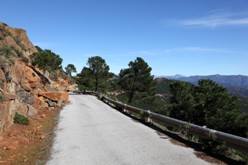California Motor Vehicle Code 21662
Mountain Driving
California vehicle code 21662 requires you to stay in control of your vehicle at all times. You must drive as far to the right side of the road as is safe to do so, and you must use your horn to signal your presence if you are going around a curb or other obstruction where oncoming vehicles may not be able to see you.
If you are driving in the mountains and your view is obstructed by trees, rocks or curves you must sound your horn within 200 feet of a curve or underpass to alert other drivers to your presence. Oncoming cars should be able to hear you even if they can't see you. Sounding your horn gives other drivers a chance to move to the far right of the road and avoid a possible collision.
curves you must sound your horn within 200 feet of a curve or underpass to alert other drivers to your presence. Oncoming cars should be able to hear you even if they can't see you. Sounding your horn gives other drivers a chance to move to the far right of the road and avoid a possible collision.
You should also drive slow enough to stay on your own side of the road and maintain proper control of your vehicle. Mountain driving can be fun and exhilarating, but it must also be safe for all drivers. If you can't see around the curve ahead of you, drivers coming in the opposite direction cannot see either. If you are driving fast, neither driver may have sufficient time to get out of the other's way.
Always sound your horn at 200 feet before a blind spot. If you are unsure what distance is 200 feet, you can think of it as approximately the distance of 10-12 cars placed end to end. You can also judge the distance as how far you can travel in 4 seconds if you are traveling 35 mph. This is the distance needed to ensure you are close enough to the curve to be heard, but far enough away to allow time for the oncoming cars to move over.








